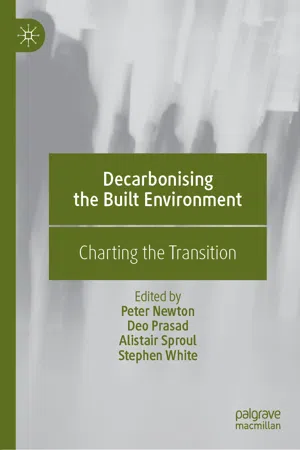Introduction
At the end of the second decade of the twenty-first century, Australia continues to face the twin challenges of a transition to renewable energy and a transition to sustainable urban development . We are lagging significantly on both fronts nationally and internationally relative to where the world needs to be (DEE 2018a; DFAT 2018; UN 2018). Yet the two are connected. Decarbonisation of the built environment will provide the basis for low carbon living—the raison d’etre of this book—drawing on applied research conducted by the Co-operative Centre for Low Carbon Living (CRC LCL ). Decarbonisation of the built environment will also drive the growth of a green economy , seen as the next major societal transformation (CPD 2010; Newton & Newman 2015; OECD 2015) that will enable sustainable economic as well urban development . Renewable energy is seen as a core sector of the green economy , but all sectors—especially those with a strong urban focus such as planning , building and construction, transport , manufacturing and services—have a major role in shrinking currently unsustainable ecological , carbon and urban footprints (IRP 2018). The co-benefits of these transitions contribute strongly to human health, well-being and liveability (Sallis et al. 2016).
These are not new challenges, but they are now urgent in the context of mounting evidence of how climate change, global population growth , rapid urbanisation, rapidly growing cities , and clear resource constraints will be impacting where and how we live in the future —unless transformational change can be implemented now.
This existential threat of climate change has been consistently broadcast to the world by leaders such as Al Gore (2006) and most recently by David Attenborough at the opening of UNFCCC’s Climate Conference (COP24) in December 2018: ‘Right now, we are facing a man-made disaster of global scale. Our greatest threat in thousands of years. Climate Change . If we don’t take action the collapse of our civilisations and the extinction of much of the natural world is on the horizon’ (Attenborough 2018, p. 1). The science of climate change is now firmly established, and its early impacts are now devastatingly clear globally and across Australia .
The UN Intergovernmental Panel on Climate Change’s science-based forecasts of greenhouse gas (GHG) emissions and global warming have underpinned the UN Framework Convention on Climate Change’s efforts since the early 1990s to secure international agreements on carbon mitigation . In December 2015 the UNFCCC Paris Agreement saw 195 countries each agree to Nationally Determined Contributions to emissions reductions , designed to limit global warming to 1.5−2.0 °C above pre-industrial levels. Australia’s Paris reduction target of CO2 was set at 26–28% below 2005 level by 2030 and net zero emissions by 2050 (ClimateWorks 2018). The Climate Council of Australia (2015) however, saw the 2030 target as inadequate, suggesting a range in emissions reduction between 45 and 65% by 2030. Current assessments by the Climate Council (2018), UNEP (2018), NDEVR (2018) and Climate Action Tracker (2019) indicate that Australia’s emissions are not declining in line with the 2030 target. Unsurprisingly perhaps, the Federal Government believes Australia will meet its target (Remeikis 2018), while Pears (2018) suggests they could be manipulated to fit, and Skarbek (2018) along with others argues that new policies are required to get the nation back on track. More optimistic forecasts are provided by Blakers, Stocks and Lu (2019) who argue that the electricity sector is on track to deliver Australia’s entire Paris emissions reduction target five years early. This may be optimistic, given the chaotic nature of the nation’s climate and energy politics over the past decade and more (Newton et al. 2018), but is potentially achievable if the current institutions don’t continue to erect barriers to renewables, storage and energy efficiency . By comparison to the Federal Government , the Labor opposition has a policy of 45% emissions reduction target by 2030; and state governments that form part of the national electricity grid (in particular NSW , Victoria , SA and ACT ) have all set net zero targets for 2050 (Jewell 2017).
The jury is still out on whether global warming can be restricted to 2 °C by 2100 (CDP, WRI & WWF
2015; Climate Council
2018; UNEP
2018). In this context,
Australia has a major set of challenges with:
Its absolute level of emissions that contribute to the global carbon budget (547.0 Mt CO2-e in June 2018: DEE 2018b)
Its per capita emissions (at 21.5t/person among the highest in the OECD: DEE 2018b; World Bank 2018)
Its sectoral emissions , especially in relation to the built environment —buildings and transport (ClimateWorks 2018); and
The size of its capital city carbon footprints (Chen et al. 2016; Teh et al., Chapter 7).
Additional and related challenges for
Australia involve:
Its rapid rate of population growth over the past decade—almost three times the OECD average (World Bank 2019)—90% of which are absorbed into its cities
How the major cities have struggled to plan for this growth in a manner that delivers sustainable urban development outcomes (DFAT 2018; House of Representatives 2018). Recent reports point to the size of their urban footprints (Coleman 2017), carbon footprints (Teh et al., Chapter 7) and ecological footprints (Newton 2017).
It was in the context of these challenges that the CRC LCL was established in 2012 as part of the national Co-operative Research Centres Program—a model unique to Australia that has been operating for over 20 years (https://www.business.gov.au/assistance/cooperative-research-centres-programme)—to undertake a 7-year programme of applied research that could assist in accelerating the decarbonisation of the built environment sector.
Pathways for Transitioning to a Low Carbon Built Environment
Decarbonisation of the built environment requires an integrated approach across multiple sectors and multiple...
